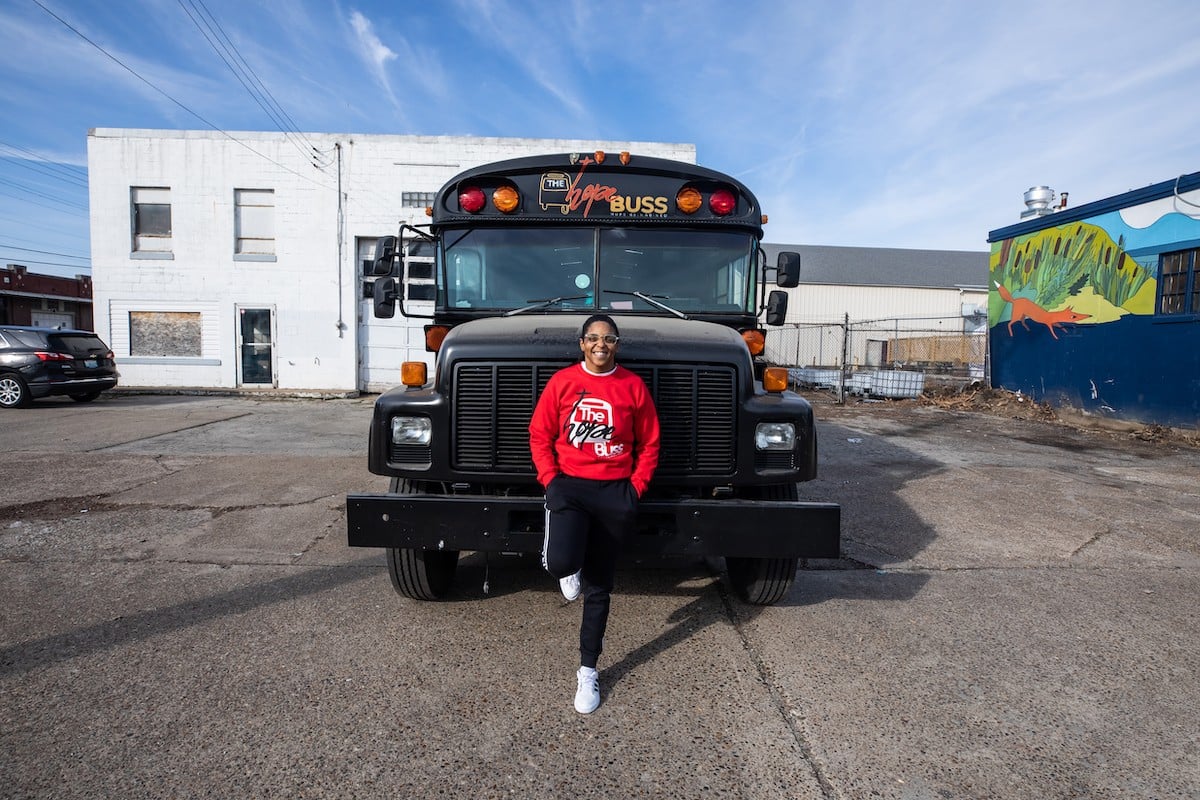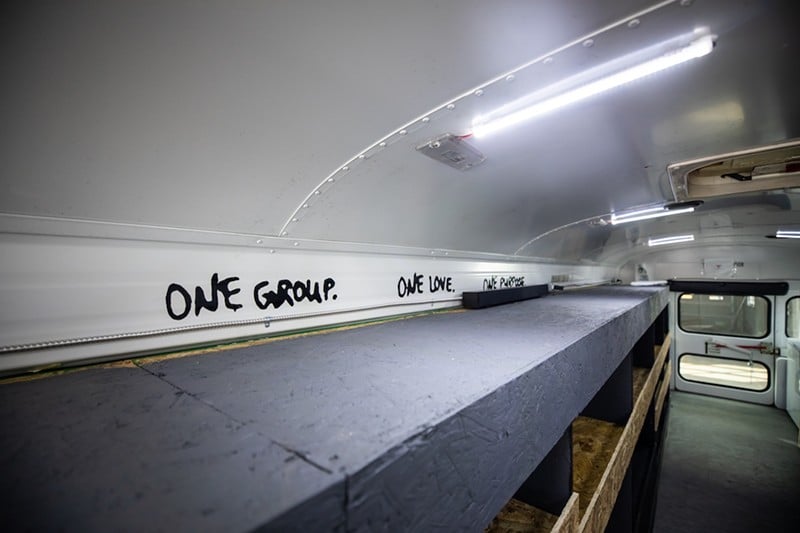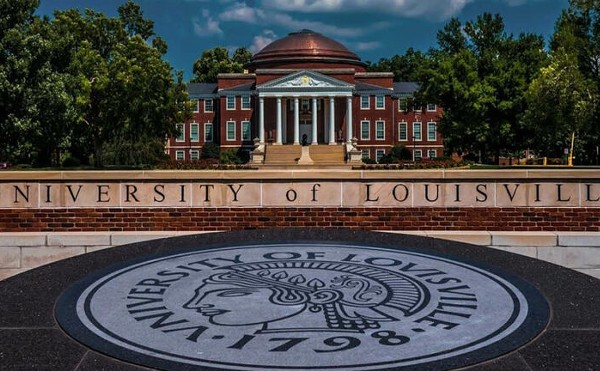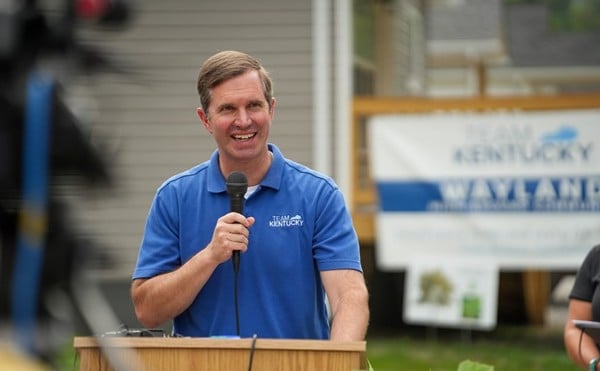When The Hope Buss began operations in 2018, it started off small: providing rides to grocery stores to people who lived in Louisville’s vast food deserts and could not otherwise get to supermarkets.
Over the years, the small nonprofit’s operations expanded, from rides to the polls on Election Day to a food pantry that delivers boxes of groceries to families in need and an emergency assistance program to help people in dire need of money for things like their utility bills, car repair or legal fees.
But now, The Hope Buss is poised to take on responsibilities of a much larger proportion: The running of the city’s safe outdoor space — which will house up to 50 homeless people living in ice fishing tents on city-owned land on the eastern edge of Old Louisville — and overseeing the program’s $1.5 million budget.
“Systemically, this project wasn’t set up for somebody like us to have it,” says Stachelle Bussey, the 34-year-old Black reverend who founded and runs the nonprofit. “You can just tell. And so we’ve had to jump through a lot of different hoops to convince people that we could do the work.”
Bussey, who grew up poor in Louisville’s mostly Black West End, started her nonprofit after seeing the glaring disparities around her and wanting to give people the help they need, not the help that others outside of their neighborhoods might think they need. It is those disparities — the lack of grocery stores, the lack of housing, just how the streetscapes of Louisville look different when you cross from East to West — that pushed The Hope Buss’s progression from grocery store runs to running a program on behalf a city whose police force Bussey marched against during the 2020 Breonna Taylor protests.
The Hope Village, as the safe outdoor space program will be called, will be a staffed and monitored encampment that will host homeless people on a referral basis. The site had been scheduled to open on or before March 1, but, according to the city, it is on track to open in mid-March. Modeled after a program in Denver, the idea is for The Hope Village to act as a hub with wraparound services that can help those living on the street transition into stable housing and get connected to help with things like substance abuse counseling and mental and physical health care. The idea is also to engage in harm reduction by meeting people where they are at, understanding that there are root causes that keep people living on the street.
“We hear stories all the time: People get in an apartment and they still pitch their tent in the living room. So it’s very much like a mentality and working with folks past that. Just giving somebody an apartment is not the answer,” says Angel Todd, The Hope Buss’ director of operations. “We have to have those wraparound services, we have to work with them to introduce them or reintroduce them to what it looks like to be in a home, to be in these four wall kind of situations.”
Hope is gritty
A few years back, Bussey was a social worker in Louisville for the state. It was horrible, and she’s blocked out when exactly she was a social worker, she tells me one February morning while wearing a camo “Hope Dealer” baseball cap in the basement of the Shawnee church that The Hope Buss is headquartered out of.During her time as a social worker, “My eyes were just widened at the way that white people got services and help and Black people got the book thrown at them,” she says.
“I saw disparities and gaps in the way that people were receiving services or help. I sat in on meetings and I watched poverty be criminalized. I just knew it wasn’t the work for me.”
Bussey says as a social worker, she’d see things differently than some of her colleagues. To her, when she’d see a single mother with five kids, with some sleeping on the couch or a mattress on the floor of the living room, she wouldn’t see a mother who couldn’t take care of her kids, she’d see somebody who was being resilient.
She also started to see what she labels “toxic charity” — charity that doesn’t take into account what people on the ground actually need. That kind of charity that might make those giving feel good about themselves, but it does not move the needle for those in need.
“I think a lot of the time, people at the top don’t talk to people at the bottom, so then it’s like, ‘Let’s just create services that we think people need,’” she says. “Well, that’s toxic charity, because it’s not an exchange, it’s not a communal exchange.”
She gives an example: “If I look at Antwone and think that Antwone’s shirt is wrinkled and he needs an iron and I say, ‘You know what? I’m going to give Antwone an iron.’ And Antwone’s like, ‘What I really need is electricity, I have an iron.’”
I ask her about the slogan on her hat, Hope Dealer. To her, hope is not always something warm and fuzzy.
“I really emphasize to people that we don’t need to romanticize hope. Because most of the time hope is dressed up as this cute thing. But it’s not. It’s gritty sometimes,” she says. “It’s not cute all the time. Hope is making the decision whether I’m going to take all these pills and take my life or I can find the one thing to live for. Like somebody makes that decision when they wake up. Hope is like finding the one thing and then when you know somebody.”
Born in the protests
Bussey heard about Breonna Taylor’s death in a botched March 2020 LMPD raid before it became big news. Ju’Niyah Palmer, Taylor’s sister, had been a student of Bussey’s at Central High School, where Bussey is an assistant band director. And Taylor’s death was being talked about in her circles, despite initially slipping below the radar of the news cycle.When spontaneous mass protests broke out on May 28, 2020 after audio of a 911 call made by Taylor’s distraught boyfriend was released by the Courier Journal, Bussey knew she had to participate. So she headed to Sixth and Jefferson, to the small downtown park tucked between the city government’s centers of power.
“Typically that space, for Black people, is like D-Day,” she says. “We don’t go down there. It’s the courthouse. It’s the jail. Our uncles. Our cousins. We don’t do gown there. You know, it’s like that space is typically the point of no return.”
Bussey quickly became a staple at the protests and a leader.
It was in the protests that Bussey saw glimmers of what society could and should be: Those who needed food were given food. Those who needed shelter were given shelter. There was music. Everybody worked together for the common good.
“What a display of what we could actually be,” she says. “This community, this city.”
And to her, being out in the streets fighting for change lined up perfectly with her Christian theology.
“I think Jesus was a radical,” she says. “He did everything to upset systems that kept people oppressed. That’s what Jesus was, right?”
At a Jan. 18 press conference where the city announced that The Hope Buss has been selected to run the safe outdoor space, Bussey talked about a Louisville transformed by the protests.
“After 2020, none of us can ever be the same,” she said. “I marched in the streets with people who I made a pledge to: That whenever I got to the table, nothing would ever be the same. This is about equity, and I think this is the beginning of our city making equitable decisions”
To Louisville’s former chief of community building Vincent James, the protests had a “tremendous” impact on how city government acted and thought.
During the protests, James acted as a liaison between the city and protesters. It was a careful balance, with both sides distrustful of the other, but it was a result of those contacts and building trust with the protest community that “our city did not burn down when it very well could have,” he says. The meetings also brought James back in regular contact with Bussey, who had been a musician at Elim Baptist Church, where he is a pastor. Overall, he says, his contacts with protesters and groups like Bussey’s raised voices and concerns from the streets to the highest levels of power in Louisville.
“Typically, that’s not the group that the city would reach out to. So I think by raising their voices, the city became aware of what the needs were in this group that typically was not the usual suspects that we wind up partnering with or working with in the community,” he says. “There’s a whole group of folks that now we have an opportunity to engage, that hadn’t had a voice before, but now when they raised their voice, we heard loud and clear.”
The selection of The Hope Buss to run the safe outdoor space shows James that the city is able to partner with smaller, community-based nonprofits and help them develop the strength and resources they need to take on larger projects.
“The city has the ability to be able to work with small community-based organizations to help them build capacity to help them take on these larger-scale projects that they’re well suited for,” he says. “She didn’t have the infrastructure for it. But working with the city, building that out, it helped her be prepared in a way that she could really be able to impact change.”
Hope Village operations
The Hope Village was originally scheduled to open on or before March 1, but it is currently slated to open by mid-March according to Susan Buchino, the city’s director of homeless services. She says supply chain and logistical issues have been responsible for the delay.Once it is opened, Hope Village will begin taking in residents on a referral basis and will house up to 50 individuals in heavy-duty ice fishing tents.The Hope Buss will position mobile showers and portable toilets at the site. They also hope to turn a carport into a community pavilion where residents can get together and receive visitors.
The city has talked about eventually renovating a vacant building on the 212 E. College St. property and using it as transitional housing, a project that they anticipate will cost $7.5 million. At its outset though, the site will be home to non-permanent structures.
Without any structures up yet and still resembling an empty lot, driving past the site on Feb. 27 it was hard to envision what the supervised encampment would look like when operational.
But once it’s up and running, The Hope Buss hopes the site will act as a stepping stone for those experiencing homelessness, empowering residents while also connecting them with the services they need.
Those living at Hope Village will also have an opportunity to do some of the necessary jobs there like food service and custodial duties. (Todd, the operations director, said she did not have an exact figure for how much that they would be paid, but said that it would be “a fairly decent wage.”)
Income is a key part of helping residents transition into stable housing, but stable income can often be hard to obtain for those who are homeless.
“This is what that stepping stone looks like,” said Todd. “Compensation for folks who don’t have any kind of income or are in that transition is very important. They’ll help with food, cleanliness, all of that.”
The Hope Village will operate on a referral model, with homeless outreach organizations recommending potential residents, who will then be reviewed by an advisory council. Todd said that two of the seats on the council will be reserved for Hope Village residents, making them a part of the running of their community.
While new residents will have to be referred, Bussey says the doors of The Hope Village will be open to give other kinds of help to those who might need it.
“People will be able to walk up and like if they need a shower, they can take a shower, or use the bathroom or get a meal. But as far as living in there, it’ll be referrals-based only,” says Bussey.
The Hope Village represents a roughly $3 million investment by the city — $1.6 million for the purchase of the property and an estimated operation budget of $1.5 million. The funds are coming from the city’s allotted federal American Rescue Plan COVID-relief money.
However, The Hope Buss was not simply handed $1.5 million to get the safe outdoor space project up and running; Rather, it is being run an a reimbursement model, with The Hope Buss having to spend first and then wait to be paid back, a process that could take between 30 and 90 days according to Todd, the operations director.
The Hope Buss is planning on hiring additional staff to help run The Hope Village, but there is the feeling that it will be a lean operation by necessity.
In the basement of the Shawnee church The Hope Buss works out of, some shelves in a room used to store food pantry donations were labeled “THV” (as in, The Hope Village) and are being piled with foodstuffs and other supplies to be used in the safe outdoor space.
Asked how the organization would get by while having to front the money for the operation of The Hope Village, Bussey says “by the grace of God.”
(Todd, the operations director, said that some partners of The Hope Buss said they can front money if needed; Bussey said she was not allowed to talk about that.)
The Hope Buss’ partnership with the city of Louisville — which will provide advisory, logistical and financial support — will take some of the financial burden off of the non-profit.
“We’ve really partnered with The Hope Buss to learn their vision and then supporting them in putting that together,” says Buchino, the city’s director of homeless services.
There are some things, like plumbing and electricity work, where the city has relationships with contractors and can get the work done quicker. And with funding running on a reimbursement model, the city is taking over payment for some of the bigger ticket items, freeing up resources for The Hope Buss. For example, the city purchased the 50 ice fishing tents, which cost $310 a piece.
According to Bussey, Hope Village will handle its own security, and she does not want the village to interact with LMPD.
“We want to explore other options for safety,” she says.
The Hope Village is located in LMPD’s 4th Division, which is set to begin a 911 diversion pilot program that would see some emergency calls routed to trained crisis interventionists and could see in-person responses from a non-police crisis intervention unit. Bussey said she hopes to work with that program, which the city says will be operational in mid-March.
Bussey said The Hope Village’s own security personnel will be trauma-informed and will patrol the area.
If a new resident arrived with a knife, she says they’d likely just hold it in storage for them until the resident left.
“It’s hard out here on the streets,” she says.
Bussey hopes that by doing the work she’s doing, she’s chipping away at the poverty that plagues Louisville — poverty that she sees as driving Louisville’s violence in the city’s back-to-back deadliest years.
“Wherever you find poverty you’re going to find violence. People think it’s the other way around, but it’s not,” she says.
Denver an inspiration
A safe outdoor space program in Denver that has been operational since 2020 has served as an inspiration to Louisville and has offered advice and logistical support to city officials and Hope Buss team members.The Colorado Village Collaborative is currently providing shelter to 136 people at three sites in Denver. A fourth site is set to open in the coming months and will bring their capacity to 200.
“What really struck me was… you could drive by these spaces and not know they were there,” says Buchino, the city’s homeless services director, who recently visited two of the Colorado Village Collaborative safe outdoor spaces. “It didn’t add chaos to the neighborhood. And the residents of the safe spaces were very grateful to be there.”
Speaking to LEO, Cuica Montoya, safe outdoor space program director at the Colorado Village Collaborative, said that the Denver safe outdoor spaces gained their initial support during the start of the COVID-19 pandemic as “a temporary solution for stay-at-home orders for people who didn’t have a home to stay at home at.”
The Denver sites utilize the same sturdy ice fishing tents that the Hope Village will, but other aspects are different. For one, the project got off the ground with private sector seed money. And while they get city government funding now after a little initial reluctance, the group has been using private land for its programs after running into complications in using city-owned land.
While people may fear that a safe outdoor space means moving an underpass-style homeless encampment to their neighborhood, Montoya says that is not the case.
“There’s a lot of fear-based feelings around folks that are experiencing homelessness, and I think that a lot of that fear is based in kind of unmanaged, unsanctioned encampments,” she said. “[A safe outdoor space] isn’t unmanaged, unsanctioned encampments; It’s a managed site that is staffed 24/7 that has connection points and resources for folks to solve their housing crisis.”
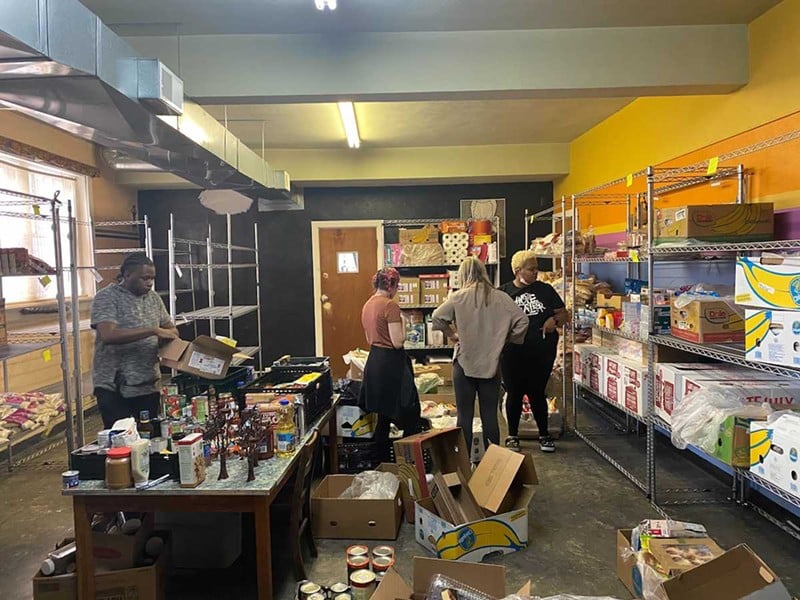
Removing barriers
When the gates of the Hope Village finally open to residents, it will not be the first time that The Hope Buss shelters the homeless.In February of 2021, severe cold was putting the lives of those living on the street in Louisville at risk. For The Hope Buss, the start of the year was typically a quiet period, a time to reevaluate and restock for the busy year ahead. But Bussey felt a call to action; She decided to open up a pop-up shelter at Unity Church where The Hope Buss had offices at the time.
She didn’t waste time trying to get any permits, she just opened the church’s doors to those who needed shelter.
“I said, ‘I don’t care, give me a fine,’” she says. “I don’t know rules, man. I specialize in people, not politics. I don’t got time to play semantics when lives are on the line.”
At the church, which is across the street from the planned Hope Village on the edge of Old Louisville, the number of people sheltered grew from about five on the first day to more than 70 the next, according to Bussey. Ultimately, “hundreds” cycled through over the course of the two weeks it was operational. The Hope Buss didn’t have cots, so they padded the floors of the church with carpets and blankets. They provided coffee, pop, snacks and cigarettes. They showed movies. They tried to treat people like they would want to be treated.
The shelter — the only experience The Hope Buss has had yet at running a housing program for homeless people — largely operated without a hitch.
It was also an example of Bussey’s do first, ask forgiveness later attitude.
“I don’t really see boundaries,” she says. “People see all these titles — like the mayor. And I’m like: ‘Can’t we just knock on the door?’”
The Hope Village is part of that barrier-breaking mission to change the world around her.
“A lot of our systems, especially in the city, teach us to do this: Dance around the barrier — not remove it. People will coach you through working around the barriers. I don’t understand that,” she says. “Like… if there’s a door and the door is the barrier, it seems to me that I would want to take it off the hinges. But people wouldn’t do that. People would teach me how to squeeze through the door, people will teach me how to take the glass out. No — I’m not doing that.”
Keep Louisville interesting and support LEO Weekly by subscribing to our newsletter here. In return, you’ll receive news with an edge and the latest on where to eat, drink and hang out in Derby City.
Follow us on Facebook, Twitter and Instagram.

